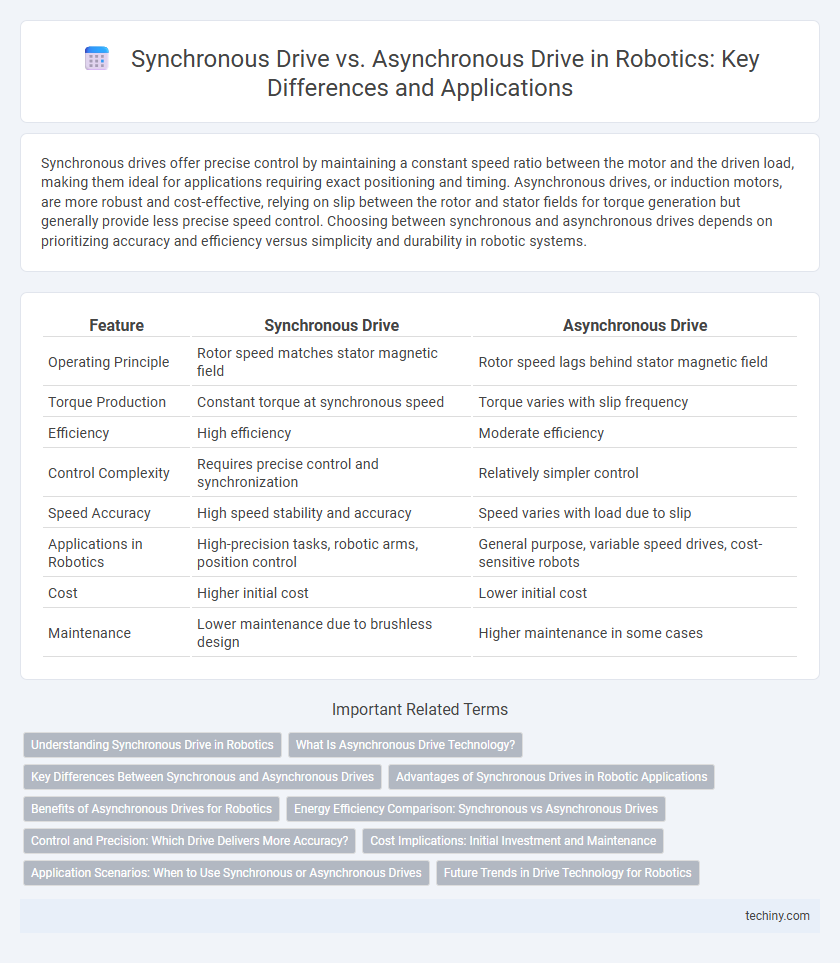Synchronous drives offer precise control by maintaining a constant speed ratio between the motor and the driven load, making them ideal for applications requiring exact positioning and timing. Asynchronous drives, or induction motors, are more robust and cost-effective, relying on slip between the rotor and stator fields for torque generation but generally provide less precise speed control. Choosing between synchronous and asynchronous drives depends on prioritizing accuracy and efficiency versus simplicity and durability in robotic systems.
Table of Comparison
| Feature | Synchronous Drive | Asynchronous Drive |
|---|---|---|
| Operating Principle | Rotor speed matches stator magnetic field | Rotor speed lags behind stator magnetic field |
| Torque Production | Constant torque at synchronous speed | Torque varies with slip frequency |
| Efficiency | High efficiency | Moderate efficiency |
| Control Complexity | Requires precise control and synchronization | Relatively simpler control |
| Speed Accuracy | High speed stability and accuracy | Speed varies with load due to slip |
| Applications in Robotics | High-precision tasks, robotic arms, position control | General purpose, variable speed drives, cost-sensitive robots |
| Cost | Higher initial cost | Lower initial cost |
| Maintenance | Lower maintenance due to brushless design | Higher maintenance in some cases |
Understanding Synchronous Drive in Robotics
Synchronous drives in robotics utilize permanent magnet synchronous motors (PMSMs) that provide precise rotor position feedback, enabling high accuracy and efficient torque control. These drives maintain constant speed matching the frequency of the supplied current, resulting in improved performance in tasks requiring precise motion control. Their ability to deliver high torque density and low inertia makes synchronous drives ideal for robotic applications demanding rapid acceleration and precise positioning.
What Is Asynchronous Drive Technology?
Asynchronous drive technology in robotics employs induction motors where the rotor speed lags behind the magnetic field's rotating speed, resulting in slip that generates torque. This technology offers robust performance, cost-effectiveness, and simpler construction compared to synchronous drives, making it suitable for varied industrial automation applications. Its ability to operate without permanent magnets reduces maintenance and enhances reliability in harsh robotic environments.
Key Differences Between Synchronous and Asynchronous Drives
Synchronous drives maintain constant speed by matching the rotor speed with the stator's rotating magnetic field, offering precise control ideal for robotics requiring exact positioning. Asynchronous drives, also known as induction drives, allow the rotor to rotate at a speed slightly different from the magnetic field, providing ruggedness and cost-efficiency with simpler control systems. Key differences include speed synchronization, control accuracy, and complexity, where synchronous drives excel in precision while asynchronous drives are preferred for durability and lower maintenance.
Advantages of Synchronous Drives in Robotic Applications
Synchronous drives offer precise speed and position control essential for high-accuracy robotic tasks, enabling smoother and more responsive movements. Their high torque density and efficiency result in improved energy savings and reduced system size, which is critical for compact robotic designs. The enhanced reliability and lower maintenance requirements of synchronous motors contribute to longer operational life and increased uptime in industrial robotic applications.
Benefits of Asynchronous Drives for Robotics
Asynchronous drives in robotics offer superior durability and cost-effectiveness compared to synchronous drives due to their simpler construction and reduced maintenance requirements. They excel in applications requiring variable speed and load fluctuations, providing reliable torque control and energy efficiency. The robustness of asynchronous motors enhances robotic system longevity, making them ideal for industrial automation environments.
Energy Efficiency Comparison: Synchronous vs Asynchronous Drives
Synchronous drives typically exhibit higher energy efficiency compared to asynchronous drives due to their ability to maintain constant speed and reduce slip losses. The precise rotor speed synchronization in synchronous motors minimizes energy wastage, resulting in improved performance in robotic applications. Conversely, asynchronous drives consume more power as slip causes additional heat generation, leading to lower overall efficiency.
Control and Precision: Which Drive Delivers More Accuracy?
Synchronous drives offer superior control and precision in robotics due to their direct coupling with the rotor's magnetic field, enabling accurate position and speed control. Asynchronous drives, relying on slip between the stator and rotor, generally produce less precise torque and position feedback, making them less ideal for high-accuracy applications. The inherent deterministic response of synchronous drives ensures better repeatability and fine control essential for robotic tasks requiring exact movements.
Cost Implications: Initial Investment and Maintenance
Synchronous drives typically incur higher initial investment costs due to their complex rotor constructions and precise control requirements compared to asynchronous drives, which utilize simpler, robust induction motors. Maintenance expenses for asynchronous drives tend to be lower since they lack brushes and slip rings, reducing wear and the need for frequent replacements. Cost-efficiency over the lifecycle often favors asynchronous drives in applications where high precision is not critical.
Application Scenarios: When to Use Synchronous or Asynchronous Drives
Synchronous drives excel in precision-driven robotics applications such as robotic arms and CNC machines, where exact speed and position control are critical. Asynchronous drives are more suitable for simple, cost-effective automation tasks like conveyor belts and fan systems, where robustness and low maintenance outweigh precise control. Choosing between synchronous and asynchronous drives hinges on the application's requirement for accuracy, speed stability, and operational complexity.
Future Trends in Drive Technology for Robotics
Synchronous drives offer precise control and higher efficiency, making them ideal for robotics requiring accurate positioning and repeatability. Asynchronous drives are gaining traction due to advancements in sensor technology and control algorithms, enabling better performance at reduced costs. Future trends emphasize integrating AI-driven adaptive control systems to optimize energy consumption and enhance the responsiveness of both synchronous and asynchronous drives in robotic applications.
Synchronous drive vs asynchronous drive Infographic

 techiny.com
techiny.com